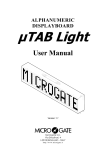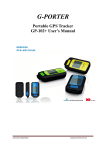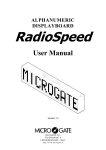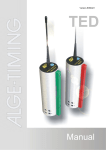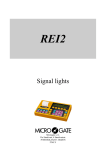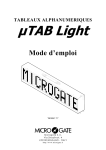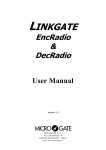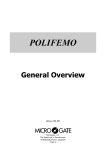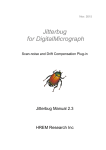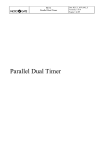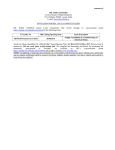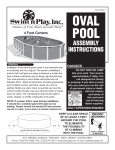Download - Microgate
Transcript
GRAPHIC DISPLAYBOARD
μGRAPH
User manual
Version 1.04
Microgate S.r.l.
Via Stradivari, 4
I-39100 BOLZANO - ITALY
http://www.microgate.it
μGRAPH Displayboard
User Manual
⎯⎯⎯⎯⎯⎯⎯⎯⎯⎯⎯⎯⎯⎯⎯⎯⎯⎯⎯⎯⎯⎯⎯⎯⎯⎯⎯⎯⎯⎯⎯⎯⎯⎯⎯⎯⎯⎯⎯⎯⎯⎯⎯⎯⎯⎯⎯
2
μGRAPH Displayboard
User Manual
3
⎯⎯⎯⎯⎯⎯⎯⎯⎯⎯⎯⎯⎯⎯⎯⎯⎯⎯⎯⎯⎯⎯⎯⎯⎯⎯⎯⎯⎯⎯⎯⎯⎯⎯⎯⎯⎯⎯⎯⎯⎯⎯⎯⎯⎯⎯⎯
INDEX
1
GRAPHIC DISPLAYBOARD µGRAPH (MICROGRAPH) ............................................................................. 4
1.1 CONTROL PANEL ................................................................................................................................................... 5
1.1.1
Serial Velocity Selector............................................................................................................................... 6
1.1.2
Connections ................................................................................................................................................ 7
1.2 RIGHT SIDE PANEL ................................................................................................................................................ 9
1.2.1
Connections .............................................................................................................................................. 10
1.3 POWER SUPPLY ................................................................................................................................................... 11
1.3.1
Battery Recharge ...................................................................................................................................... 11
1.4 MODULAR ASSEMBLY ......................................................................................................................................... 13
1.5 VIA RADIO SYSTEM ............................................................................................................................................. 16
1.6 µGRAPH FIRMWARE .......................................................................................................................................... 16
1.6.1
Updating of Firmware .............................................................................................................................. 17
2
PROGRAMS ......................................................................................................................................................... 18
2.1 PROGRAM 0 (NORMAL) ....................................................................................................................................... 19
2.2 PROGRAM 1 (MEMORY PROGRAM)...................................................................................................................... 21
2.3 PROGRAM 2 (CHRONOMETER)............................................................................................................................. 22
2.4 PROGRAM 3 (SPEEDMETER)................................................................................................................................. 23
2.5 PROGRAM 4 (COUNTDOWN) ................................................................................................................................ 26
2.6 PROGRAM 5 (INTERNAL CLOCK) ......................................................................................................................... 28
2.7 PROGRAM 6 (INTERNAL CLOCK & DATE)............................................................................................................ 29
2.8 PROGRAM 7 (LAP CHRONOMETER)...................................................................................................................... 30
2.9 PROGRAM 9 (TEST).............................................................................................................................................. 31
2.10 PROGRAM 10 (SELF TIMING) ............................................................................................................................... 32
2.10.1
Starting Coin Box................................................................................................................................. 32
2.10.2
Finish displayboard ............................................................................................................................. 32
2.10.3
Printer .................................................................................................................................................. 33
2.10.4
Functioning of Self-Timing Systems..................................................................................................... 33
2.10.5
Parameters setting ............................................................................................................................... 34
2.10.6
Default value of the Self Timing editable parameters .......................................................................... 36
2.10.7
Some suggestions ................................................................................................................................. 36
2.11 DEFAULT VALUES OF EDITABLE PARAMETERS ..................................................................................................... 37
3
APPENDIX ............................................................................................................................................................ 38
3.1 APPENDIX A: μGRAPH SERIAL FRAME .............................................................................................................. 39
3.1.1
Text Frame................................................................................................................................................ 39
3.1.1.1
3.1.1.2
3.1.2
3.1.3
Proportional and Non-Proportional Fonts............................................................................................... 48
Graphic Frame ......................................................................................................................................... 49
3.1.3.1
3.1.3.2
3.1.3.3
3.1.4
3.1.5
3.1.6
Text Frame format and Command Table..........................................................................................................41
Syntax of Text Frame commands .....................................................................................................................42
Graphic Frame format and Command table......................................................................................................50
Active Objects ..................................................................................................................................................51
Syntax of Graphic Frame commands................................................................................................................52
Resetting a Displayboard Area ................................................................................................................. 55
Font Selection ........................................................................................................................................... 55
Example .................................................................................................................................................... 56
3.1.6.1
Fixed string writing with graphic frame ...........................................................................................................56
3.2 APPENDIX B ........................................................................................................................................................ 57
3.2.1
Coin Box Connections............................................................................................................................... 57
μGRAPH Displayboard
User Manual
⎯⎯⎯⎯⎯⎯⎯⎯⎯⎯⎯⎯⎯⎯⎯⎯⎯⎯⎯⎯⎯⎯⎯⎯⎯⎯⎯⎯⎯⎯⎯⎯⎯⎯⎯⎯⎯⎯⎯⎯⎯⎯⎯⎯⎯⎯⎯
1
GRAPHIC
DISPLAYBOARD
µGRAPH
(MICROGRAPH)
4
μGRAPH Displayboard
5
User Manual
⎯⎯⎯⎯⎯⎯⎯⎯⎯⎯⎯⎯⎯⎯⎯⎯⎯⎯⎯⎯⎯⎯⎯⎯⎯⎯⎯⎯⎯⎯⎯⎯⎯⎯⎯⎯⎯⎯⎯⎯⎯⎯⎯⎯⎯⎯⎯
1.1
CONTROL PANEL
1. 5 pole Nucletron Connector for Linkgate
2.
3.
system input
4 way DIP-SWITCH Selector for SERIAL
input mode selection
Jack Connector for external speaker
connection
On/Off switch
Fuse Cavity
Internal battery status signal Led
4.
5.
6.
7. Green
button
START
STOP
(MODIFY
DISCHARGE/CHARGE)
used for:
• manual START and STOP
signals
• modification of values in
program setting (keep pressed
down for fast forward)
• selection of battery discharge
and recharge
8. Yellow button LAP RESET (SETUP
DIRECT CHARGE) used for:
• manual LAP signals and
displayboard RESET
• confirmation
of
program
settings
• selection of immediate battery
recharge selection
9. Rotating selector for setting of
displayboard “line”
selector
for
displayboard “column”
10. Rotating
11. Rotating selector for program selection
12. 7 pole Amphenol connector for external power supply and battery recharge
13. 6 pole Amphenol input/output connector for serial 1
14. 6 pole Amphenol input/output connector for Serial 2
15. 6 pole Amphenol connector for connection of SELF TIMING systems
16. 6 pole Amphenol analog input connector
17. 6 pole Amphenol digital input connector
18. 6 pole Amphenol input connector for START, STOP, LAP and AUX signals
19. START input banana jack
20. STOP input banana jack
21. LAP input banana jack
22. AUX input banana jack
23. Ground banana jacks
setting
of
μGRAPH Displayboard
6
User Manual
⎯⎯⎯⎯⎯⎯⎯⎯⎯⎯⎯⎯⎯⎯⎯⎯⎯⎯⎯⎯⎯⎯⎯⎯⎯⎯⎯⎯⎯⎯⎯⎯⎯⎯⎯⎯⎯⎯⎯⎯⎯⎯⎯⎯⎯⎯⎯
1.1.1 Serial Velocity Selector
DIP-SWITCH for selection of velocity and serial protocol when μGRAPH displayboard is connected
to external control systems (PC, REI2).
ON
1200 Baud
OFF OFF OFF OFF
1
2
3
4
ON
2400 Baud
ON OFF OFF OFF
1
2
3
4
ON
4800 Baud
OFF ON OFF OFF
1
2
3
4
ON
9600 Baud
ON ON OFF OFF
1
2
3
4
ON
19200 Baud
OFF OFF ON OFF
1
2
3
4
ON
28800 Baud
ON OFF ON OFF
1
2
3
4
ON
38400 Baud
OFF ON ON OFF
1
2
3
4
ON
Radio
ON ON ON OFF
1
2
3
4
ON
1
Dip switch 4: RS232/RS485
Position OFF: RS232 interface
2
3
4
ON
Dip switch 4: RS232/RS485
Position ON: RS485 interface
1
2
3
4
μGRAPH Displayboard
7
User Manual
⎯⎯⎯⎯⎯⎯⎯⎯⎯⎯⎯⎯⎯⎯⎯⎯⎯⎯⎯⎯⎯⎯⎯⎯⎯⎯⎯⎯⎯⎯⎯⎯⎯⎯⎯⎯⎯⎯⎯⎯⎯⎯⎯⎯⎯⎯⎯
1.1.2 Connections
•
1
2
3
4
5
6
7
SUPPLY Input (7 pole Amphenol)
Ground
Ground
Ground
External Supply (8-25V)
External Supply (8-25V)
External Supply (8-25V)
Remote on/off input
7 pole Amphenol cable connector
•
1
2
3
4
5
6
•
1
2
3
4
5
6
•
1
2
3
4
5
6
SERIAL 1 Input/Output (6 pole Amphenol)
SERIAL 1 output RS232 TX
SYNC IN
SERIAL 1 input RS485 + RX
SERIAL 1 input RS485 - RX
Ground (cable braiding)
SERIAL 1 input RS232 RX
SERIAL 2 Output (6 pole Amphenol)
Serial 2 output RS232 TX
Serial 1 output RS232 TX
Serial 2 output RS485 +
Serial 2 output RS485 Ground
SYNC OUT
SELF TIMING Input/Output (6 pole Amphenol)
START signal
COIN signal
PARALLEL signal
REDLINE signal
AUX signal
GREENLINE signal
6 pole Amphenol cable connector
μGRAPH Displayboard
8
User Manual
⎯⎯⎯⎯⎯⎯⎯⎯⎯⎯⎯⎯⎯⎯⎯⎯⎯⎯⎯⎯⎯⎯⎯⎯⎯⎯⎯⎯⎯⎯⎯⎯⎯⎯⎯⎯⎯⎯⎯⎯⎯⎯⎯⎯⎯⎯⎯
•
1
2
3
4
5
6
•
1
2
3
4
5
6
ANALOG Input (6 pole Amphenol)
ANALOG 0 input
ANALOG 1 input
ANALOG 2 input
Not connected
Not connected
Not connected
DIGITAL Input/Output (6 pole Amphenol)
DIGITAL 0 input/output
DIGITAL 1 input/output
DIGITAL 2 input/output
DIGITAL 3 input/output
Ground
DIGITAL 4 output
6 pole Amphenol cable connector
•
1
2
3
4
5
6
START – STOP – LAP Input/Output (6 pole Amphenol)
START signal
External supply
Ground
LAP signal
STOP signal
AUX signal
μGRAPH Displayboard
User Manual
9
⎯⎯⎯⎯⎯⎯⎯⎯⎯⎯⎯⎯⎯⎯⎯⎯⎯⎯⎯⎯⎯⎯⎯⎯⎯⎯⎯⎯⎯⎯⎯⎯⎯⎯⎯⎯⎯⎯⎯⎯⎯⎯⎯⎯⎯⎯⎯
1.2
RIGHT SIDE PANEL
1. 6 pole Amphenol connector for control of next μGraph in sequence when two or more
displayboards are connected on the same line
2. 7 pole Amphenol connector for power supply of next μGraph in sequence when two or more
displayboards are connected on the same line
μGRAPH Displayboard
User Manual
10
⎯⎯⎯⎯⎯⎯⎯⎯⎯⎯⎯⎯⎯⎯⎯⎯⎯⎯⎯⎯⎯⎯⎯⎯⎯⎯⎯⎯⎯⎯⎯⎯⎯⎯⎯⎯⎯⎯⎯⎯⎯⎯⎯⎯⎯⎯⎯
1.2.1 Connections
•
1
2
3
4
5
6
•
1
2
3
4
5
6
7
REAR SERIAL Output (6 pole Amphenol)
Not connected
SYNC OUT
Ground
Ground
Not connected
TX of REAR SERIAL
6 pole Amphenol cable connector
SUPPLY Output (7 pole Amphenol)
Ground
Ground
Ground
External supply
External supply
External supply
Remote on/off output
7 pole Amphenol cable connector
μGRAPH Displayboard
User Manual
11
⎯⎯⎯⎯⎯⎯⎯⎯⎯⎯⎯⎯⎯⎯⎯⎯⎯⎯⎯⎯⎯⎯⎯⎯⎯⎯⎯⎯⎯⎯⎯⎯⎯⎯⎯⎯⎯⎯⎯⎯⎯⎯⎯⎯⎯⎯⎯
1.3
POWER SUPPLY
Power can be supplied in three ways:
• By connecting the µGRAPH displayboard to the MICROGATE battery charger. In this way it is
possible to supply a mains graphic displayboard and to keep the batteries charged at the same
time. This guarantees perfect functioning also when the mains power supply is interrupted. The
ACC062 adaptor accepts an input of alternate current at 50 or 60Hz, within a range of 100 and
240 Volts
• By using the internal batteries of the displayboard. In this case autonomy is usually above 30
hours of continuous functioning (depending on the type of display used).
• By connecting the displayboard to any continuous current supply (whether steady or not)
between 10 and 30 Volts which is able to supply at least 30W peak power and about 4W
average power. A car battery guarantees several days’ autonomy.
If 2 or more µGRAPH displayboards must be powered, a single dedicated adaptor can be
requested from MICROGATE.
Important note: the adaptor ACC062 for the µGRAPH displayboard is not suitable for outdoor
use. Consequently Microgate does not accept any responsibility for damage to persons or things
due to incorrect use of the adaptor.
1.3.1 Battery Recharge
If the batteries are low, either the discharge/recharge or the immediate recharge procedure can be
carried out.
In the first case, the batteries are first discharged and only subsequently recharged. This allows the
batteries to maintain their original capacity over a long period.
To select discharge/recharge, keep the “START STOP (MODIFY CHARGE/DISCHARGE)”
button on the control panel pressed down for at least 2 seconds with the displayboard
switched off after connecting an external power source to the connector SUPPLY. The operation
will take from a minimum 7 hours to a maximum of about 10 hours, depending on the initial battery
charge level.
If you choose immediate recharge instead, the operation will last about 7 hours. However, although
this type of recharge takes less time, it should only be used in exceptional circumstances as it
shortens the life of the batteries.
To select immediate recharge, keep the yellow “LAP RESET (SETUP DIRECT CHARGE)”
button on the control panel pressed down for at least 2 seconds with the displayboard
switched off after connecting an external power source to the connector SUPPLY.
In both recharge modes it is possible to interrupt the process by pressing the START STOP and
LAP RESET keys simultaneously.
μGRAPH Displayboard
User Manual
12
⎯⎯⎯⎯⎯⎯⎯⎯⎯⎯⎯⎯⎯⎯⎯⎯⎯⎯⎯⎯⎯⎯⎯⎯⎯⎯⎯⎯⎯⎯⎯⎯⎯⎯⎯⎯⎯⎯⎯⎯⎯⎯⎯⎯⎯⎯⎯
The LOW BATTERY led on the control panel tells you the battery charge status, the type of power
source used and the recharge operation status when the battery is being recharged.
EXTERNAL SUPPLY
STATUS
• ON/OFF Displayboard
• Batteries Charged
• ON/OFF Displayboard
• Batteries Discharged
LOW BATTERY LED
Green – Green – Pause
Green – Red – Pause
INTERNAL SUPPLY (BATTERY)
STATUS
• OFF Displayboard
• Batteries Charged or Discharged
• ON Displayboard
• Batteries Charged
• ON Displayboard
• Batteries Discharged
LOW BATTERY LED
OFF
Green – Pause – Green – Pause
Red – Pause – Red – Pause
DISCHARGE/CHARGE
STATUS
• Start of Discharging
• Discharging Over – Start of Recharging
• Recharging Over
DIRECT CHARGE
LOW BATTERY LED
STATUS
• Start of Recharging
• Recharging Over
LOW BATTERY LED
Pause – Green – Pause – Green FAST
Green Continous
Pause – Green – Pause – Green FAST
Green Continous
μGRAPH Displayboard
13
User Manual
⎯⎯⎯⎯⎯⎯⎯⎯⎯⎯⎯⎯⎯⎯⎯⎯⎯⎯⎯⎯⎯⎯⎯⎯⎯⎯⎯⎯⎯⎯⎯⎯⎯⎯⎯⎯⎯⎯⎯⎯⎯⎯⎯⎯⎯⎯⎯
1.4
MODULAR ASSEMBLY
One of the greatest advantages of μGRAPH is that a number of displayboards can be put together
to increase the length of the strings and images displayed. A single μGRAPH has a resolution of
24x90 pixels, while connecting up 3 displayboards in series, for example, would make it possible to
show displays with a resolution of 24x270 pixels without spaces between one displayboard and the
next. Each displayboard is distinguished by its position (line and column) defined by the rotating
selector on the control panel. Consequently the selector of the first displayboard must be set at
ROW 0 and COLUMN 0, the second, to its right, at ROW 0 and COLUMN 1 (and so on) before
connecting up as described below.
This feature makes it possible to put together up to a maximum of 9 displayboards without taking
apart their external casing, and is quite easy to do.
DISPLAYBOARD A
PHASE 1:
DISPLAYBOARD B
a.
Unscrew the 4 screws
in the side panel on the
right
of
DISPLAYBOARD A and
remove the panel.
b.
Unscrew the 2 locking
pins on the right of
DISPLAYBOARD A.
c.
Pull out the two
sliding
plates
of
DISPLAYBOARD A as
far as they will go.
d.
Screw in the 2 locking
pins
of
DISPLAYBOARD A to
block the sliding plates.
e.
Unscrew the 4 screws
in the side panel on the
left of DISPLAYBOARD
B and remove the panel.
f.
Unscrew the 2 locking
pins on the left of
DISPLAYBOARD B.
μGRAPH Displayboard
14
User Manual
⎯⎯⎯⎯⎯⎯⎯⎯⎯⎯⎯⎯⎯⎯⎯⎯⎯⎯⎯⎯⎯⎯⎯⎯⎯⎯⎯⎯⎯⎯⎯⎯⎯⎯⎯⎯⎯⎯⎯⎯⎯⎯⎯⎯⎯⎯⎯
DISPLAYBOARD A
DISPLAYBOARD B
PHASE 2:
a. Connect the power socket (7 pole amphenol, the cable with the larger diameter) of DISPLAYBOARD A to the
external connector SUPPLY of DISPLAYBOARD B.
a.
b. Connect the REAR SERIAL socket (6 pole amphenol, the cable with the smaller diameter) of
DISPLAYBOARD A to the SERIAL 1 connector of DISPLAYBOARD B.
c. Bring the two displayboards together so that the sliding plates of DISPLAYBOARD A fit into the slot designed for
them in DISPLAYBOARD B.
DISPLAYBOARD A
DISPLAYBOARD B
PHASE 3
a.
Screw in the 2 locking pins on the left of DISPLAYBOARD B.
μGRAPH Displayboard
User Manual
15
⎯⎯⎯⎯⎯⎯⎯⎯⎯⎯⎯⎯⎯⎯⎯⎯⎯⎯⎯⎯⎯⎯⎯⎯⎯⎯⎯⎯⎯⎯⎯⎯⎯⎯⎯⎯⎯⎯⎯⎯⎯⎯⎯⎯⎯⎯⎯
With this method it is also possible to join two or more lines of displayboards:
PC - CHRONOMETER
SERIAL 2
OUT
SERIAL 1
IN
SERIAL 2
OUT
SERIAL 1
IN
SERIAL 2
OUT
SERIAL 1
IN
In this configuration, each line of displayboards (maximum 9 per line) must be powered separately
through the first displayboard on the left. For data exchange between the lines, each first
displayboard must be connected to the one below it as in the figure: the signal coming from
SERIAL 2 of the displayboard above passes to SERIAL 1 of the displayboard below through a
special connection cable.
It is important to set the position of the displayboard on the rotating selector of the control panel. In
the example given, the first displayboard at the top left will have ROW 0 and COLUMN 0, the one
to its right ROW 0 and COLUMN 1, the first in the middle on the left ROW 1 and COLUMN 0, the
one to its right ROW 1 and COLUMN 1, the first at the bottom left ROW 2 and COLUMN 0 and
finally the one to its right ROW 2 and COLUMN 1.
Another possibility is to join two or more lines without external casing. This will increase not only
the length of the texts and images displayed, but also their width. Using 4 displayboards, for
example, gives a resolution of 48x180 pixels without breaks. Also in this case the position of the
displayboards must be set as for modular connections between two or more lines of μGraphs with
external casing (see above).
In this way it is possible to connect up to 16 lines of 9 displayboards, each for a total of 810x384
pixels. To be able to exploit this second possibility you are advised to contact MICROGATE for the
preparation of a special casing.
μGRAPH Displayboard
User Manual
16
⎯⎯⎯⎯⎯⎯⎯⎯⎯⎯⎯⎯⎯⎯⎯⎯⎯⎯⎯⎯⎯⎯⎯⎯⎯⎯⎯⎯⎯⎯⎯⎯⎯⎯⎯⎯⎯⎯⎯⎯⎯⎯⎯⎯⎯⎯⎯
1.5
VIA RADIO SYSTEM
Some programs for the μGRAPH displayboard (see par. 0Program on p.18) make it possible to
use the Linkgate radio system connected through Decoder or DecRadio to the RADIO connector
situated on the µGRAPH control panel. Thanks to Linkgate it is possible to transmit START STOP
and LAP signals from a long distance and, in Program 0 (Normal), serial data.
For further information about the Linkgate system, consult the appropriate REFERENCE MANUAL.
In the following paragraphs, the possibility of using the via radio system will be indicated by a
section RADIO.
NOTE: To be able to use the Linkgate system in, Program 3 (Speedmeter) and Program 7 (Lap
Chronometer) the radio channel must be set in Program 0 (Normal) (see p.19) of the µGRAPH.
To be able to transmit control commands in Program 0 (Normal) via radio the DIP SWITCH on the
control panel must be set to RADIO (see par. 0 Serial Velocity Selector on p.6).
1.6
µGRAPH FIRMWARE
Every time it is switched on, μGRAPH displays the firmware version stored at that moment:
VERSIONE
HARDWARE
HARDWARE
VERSION
TIPO
DI FIRMWARE
FIRMWARE
TYPE
VERSIONE FIRMWARE
FIRMWARE VERSION
Figure 1
μGRAPH Displayboard
User Manual
17
⎯⎯⎯⎯⎯⎯⎯⎯⎯⎯⎯⎯⎯⎯⎯⎯⎯⎯⎯⎯⎯⎯⎯⎯⎯⎯⎯⎯⎯⎯⎯⎯⎯⎯⎯⎯⎯⎯⎯⎯⎯⎯⎯⎯⎯⎯⎯
As can be noted in Figure 1, the numerical code of the firmware consists of 3 parts:
1. Harware Version, the first number: indicates the version of the motherboard which controls the
displayboard.
2.
Type of Firmware, the second number, varies according to the programs that can be
performed with the displayboard acquired:
•
1
=
Standard Firmware
•
2
=
Standard Firmware with Program 10 (Self Timing) enabled
3. Firmware Version, the last two numbers: it is important to provide the MICROGATE staff with
this number if you require technical assistance.
1.6.1 Updating of Firmware
Free μGRAPH Firmware updating is possible by downloading the latest versions from the site
http://www.microgate.it or requesting them from MICROGATE.
Once the update file has been obtained, the operations to be performed are simple:
A. Switch off μGRAPH and set the rotating selectors ROW, COLUMN and PROGRAM to 15,15
and 15
B. Press the START STOP (MODIFY) e LAP RESET (SETUP) buttons simultaneously and, while
keeping them pressed down, switch on the displayboard (attention, the power supply must be
disconnected before switching on the displayboard); the led on the displayboard should slowly
blink red-green.
C. Connect the PC serial to the μGRAPH SERIAL 1 connector (using the 20m CAB010 cable or
the 2m CAB001)
D. From the PC run the uFlasher program containing the latest Firmware version. During
programming, the LOW BATTERY led on the displayboard turns ORANGE.
E. After about 2 minutes programming is over (uFlasher shows the message "Device successfully
programmed"). At this point, the led turns GREEN.
F. The μGRAPH Firmware has been successfully updated. Now you can switch off the
displayboard and change the settings on the rotating selectors ROW, COLUMN and
ADDRESS.
Any error in programming is indicated by the LOW BATTERY led on the displayboard, which turns
RED. In the unlikely eventuality that this should happen, simply repeat the procedure indicated
above.
μGRAPH Displayboard
User Manual
18
⎯⎯⎯⎯⎯⎯⎯⎯⎯⎯⎯⎯⎯⎯⎯⎯⎯⎯⎯⎯⎯⎯⎯⎯⎯⎯⎯⎯⎯⎯⎯⎯⎯⎯⎯⎯⎯⎯⎯⎯⎯⎯⎯⎯⎯⎯⎯
2 PROGRAMS
μGRAPH Displayboard
19
User Manual
⎯⎯⎯⎯⎯⎯⎯⎯⎯⎯⎯⎯⎯⎯⎯⎯⎯⎯⎯⎯⎯⎯⎯⎯⎯⎯⎯⎯⎯⎯⎯⎯⎯⎯⎯⎯⎯⎯⎯⎯⎯⎯⎯⎯⎯⎯⎯
2.1
PROGRAM 0 (NORMAL)
By selecting the Program 0 (Normal) it is possible to command µGRAPH through the SERIAL 1
serial communication port or the RADIO connector.
The commands that can be given to µGRAPH are listed in par.0 Appendix A: µGRAPH Serial
Frame on p.39. We strongly recommend that the less expert should exploit the versatility of the
MICROGATE µBOARDS software to control µGRAPH correctly rather than making tedious
attempts at direct programming.
Note: the commands identified as ‘priority’ or ‘non-priority’ (or ‘strong’ and ‘weak’) should be
understood as being priority or non-priority in relation to the pause command. For example, a
‘Weak reset’ command given after a command pause will be carried out only at the end of the
pause. A ‘Strong reset’ command, on the other hand, will be carried out directly.
RADIO: When the Linkgate system via radio is used in Program 0 (Normal), the type of radio
signal used is different from that of the other programs and it is advisable not to exceed a
transmitter/receiver distance greater than 150m.
DECRADIO
BLUE
SOCKET
ENCRADIO
TO REI2, RACETIME2 OR PC
RADIO INPUT
CAB0xx
MODEM BUTTON
BLACK
SOCKET
uGRAPH
Figure 2
As can be seen in Figure 2, the DecRadio (or Decoder) is connected directly to the RADIO
connector on the displayboard, whereas the EncRadio (or Encoder) is connected to a PC, REI2 or
RACETIME2 with the appropriate cable (CAB073 for PC, CAB075 for RACETIME2 and CAB071
with CONNECTION BOX for REI2). To begin communication, the MODEM button on EncRadio
must be rhythmically pressed 3 times. Data transmission will take place at a velocity of 1200 bit/s.
μGRAPH Displayboard
20
User Manual
⎯⎯⎯⎯⎯⎯⎯⎯⎯⎯⎯⎯⎯⎯⎯⎯⎯⎯⎯⎯⎯⎯⎯⎯⎯⎯⎯⎯⎯⎯⎯⎯⎯⎯⎯⎯⎯⎯⎯⎯⎯⎯⎯⎯⎯⎯⎯
If 2 or more µGraphs commanded via Radio are being used, a special connector (ACC087) must
be connected to SERIAL 1 of the first displayboard. Without this connector pins 1 and 6 of the
Amphenol must be bridged.
•
1
2
3
4
5
6
SERIAL 1 Input/Output (6 pole Amphenol)
SERIAL 1 output RS232 TX
SYNC IN
SERIAL 1 input RS485 + RX
SERIAL 1 input RS485 - RX
Ground (cable braiding)
SERIAL 1 input RS232 RX
6 poles Amphenol cable connector
Setup
In Program 0 (Normal), setup allows you to re-initialize all µGRAPH parameters to standard values
and to set the first column displayed on the displayboard. The latter configuration makes it possible
to use two or more displayboards placed side by side. For example, if the displayboard is the
second element of the line, the first column will have to be set to 9.
Keep LAP-SETUP pressed for at least two seconds to enter Setup
Font: SMALL
Set the Font type required with START-MODIFY (SMALL 6x7 pixels,
MEDIUM (proportional medium) 10xvariable pixels, HUGE 22x14
pixels, SPECIAL 24x14 pixels, MED.FIXED (non-proportional medium
10x7 pixels))
Press LAP-SETUP
Font: SMALL
X offset: 10
Font: SMALL
X offset: 10
Radio Ch.= 10
Offset the text displayed towards the right in relation to the left edge
with START-MODIFY (form 0 to 89)
Press LAP-SETUP
Set the Radio channel with START-MODIFY (from 0 to 127 except
channel 55)
Press LAP-SETUP
Green: INITIALIZE
Press START-MODIFY to confirm, LAP-SETUP to exit without initializing
Sure ? (Green)
Press START-MODIFY to confirm, LAP-SETUP to exit without initializing
μGRAPH Displayboard
User Manual
21
⎯⎯⎯⎯⎯⎯⎯⎯⎯⎯⎯⎯⎯⎯⎯⎯⎯⎯⎯⎯⎯⎯⎯⎯⎯⎯⎯⎯⎯⎯⎯⎯⎯⎯⎯⎯⎯⎯⎯⎯⎯⎯⎯⎯⎯⎯⎯
2.2
PROGRAM 1 (MEMORY PROGRAM)
Program 1 allows you to automatically run the previously set program. This program must be
stored while µGRAPH is in Program 0. To store the program, send the command 'Program Start',
then the sequence of commands that make up the program, finally the 'Program End' command.
Besides the normal commands, a program can contain loops with instructions automatically
repeated more than one time or an infinite number of times. The commands to be repeated must
be preceeded by the command 'Label', which makes it possible to define the position of the
program from which the commands to be repeated start. This command sequence must end with
the command 'Loop-Goto' which allows you to define the number of times the loop must be
repeated.
μGRAPH Displayboard
User Manual
22
⎯⎯⎯⎯⎯⎯⎯⎯⎯⎯⎯⎯⎯⎯⎯⎯⎯⎯⎯⎯⎯⎯⎯⎯⎯⎯⎯⎯⎯⎯⎯⎯⎯⎯⎯⎯⎯⎯⎯⎯⎯⎯⎯⎯⎯⎯⎯
2.3
PROGRAM 2 (CHRONOMETER)
In this mode µGRAPH works as a typical chronometer set to 1/100 of a second.
• With Start (manually, from input or via radio) the chronometer starts.
• With Lap (manually, from input or via radio) the chronometer shows an intermediate time
for 5 seconds.
• With manual Start or Stop from input or via radio the chronometer stops.
• Now it is possible to set the chronometer to zero by pressing Lap.
If the chronometer is not set to zero, it will start from the value shown.
If the Autoreset time has been set to follow every Stop (or manual Start), the chronometer resets
itself to zero after the preset time.
NOTE: If the printer is connected, times are printed, coupled to a progressive counter that is
automatically set to zero every time mode 2 is selected or µGRAPH is switched off.
RADIO: Program 2 (Chronometer) can also be used with a Linkgate system via radio. After the
radio channel has been correctly set (see par. 0 Program 0 (Normal) on p.19) the µGRAPH
displayboard will also accept START, LAP and STOP signals coming from Linkgate.
Setup
It is possible to set the starting time of the chronometer.
Keep LAP-SETUP pressed for at least two seconds to enter Setup
Set Starttime
HH= 0
Set the hours with START-MODIFY
Press LAP-SETUP
Set Starttime
MM= 0
Set Starttime
SS= 0
Set Starttime
mm= 0
Set Starttime
mm= 0
Autores. Time= 0
Set the minutes with START-MODIFY
Press LAP-SETUP
Set the seconds with START-MODIFY
Press LAP-SETUP
Set the thousandths with START-MODIFY
Press LAP-SETUP
Set the automatic Reset time with START-MODIFY (in seconds). A
time of zero disables the Autoreset function.
Press LAP-SETUP
The chronometer is now stopped on the set time, ready to start.
μGRAPH Displayboard
23
User Manual
⎯⎯⎯⎯⎯⎯⎯⎯⎯⎯⎯⎯⎯⎯⎯⎯⎯⎯⎯⎯⎯⎯⎯⎯⎯⎯⎯⎯⎯⎯⎯⎯⎯⎯⎯⎯⎯⎯⎯⎯⎯⎯⎯⎯⎯⎯⎯
2.4
PROGRAM 3 (SPEEDMETER)
This mode allows you to measure the speed on the basis of any length. The speed is calculated on
the basis of the measurement of the time interval between two LAP-STOP input or via radio or
manual LAP-START impulses. So you need only place two photocells at the desired distance and
connect them to the Lap and Stop inputs. If the bidirectional mode has been set, the measurement
base can be run in both directions. Bidirectional mode is not recommended if it is not essential.
The system is able to manage up to 20 transits at the same time in the measurement base.
If a delay has been set for the activation of the stored program (see "Setup" below), when this time
is completed after the last measurement made, the display of the sequence stored as program is
automatically started. This auxiliary function allows automatic display of information or advertising
during the pauses between transits.
If the printer is connected, the speeds are printed, coupled to a progressive counter which is
automatically set to zero every time you enter mode 3 or µGRAPH is switched off.
NOTE: obviously, speed measurement precision depends on the accuracy with which time is
measured on the measurement base. To have a precision of 0.025 Km/h up to speeds of 130
Km/h, you need only place the photocells at least 10 m apart (using MICROGATE photocells).
Increasing the distance increases measurement precision.
POLIFEMO
ENCRADIO (Stop)
RADIO: As well as giving the manual LAP and START signals or input LAP or STOP, a Linkgate
system via radio can be used. In this case the following options are available:
A. Use of 2 Polifemo photocells and 2 Encoders or EncRadios. The signal of the first
EncRadio must be set on LAP (any), and that of the second on STOP.
ENCRADIO (any Lap)
POLIFEMO
DECRADIO
RADIO INPUT
BANANA CUBE
uGRAPH
BANANA CUBE
Figure 3
μGRAPH Displayboard
24
User Manual
⎯⎯⎯⎯⎯⎯⎯⎯⎯⎯⎯⎯⎯⎯⎯⎯⎯⎯⎯⎯⎯⎯⎯⎯⎯⎯⎯⎯⎯⎯⎯⎯⎯⎯⎯⎯⎯⎯⎯⎯⎯⎯⎯⎯⎯⎯⎯
In the example shown in Figure 3, 2 Polifemos connected to EncRadio through Banana Cube have
been used.
It is important to point out that if the EncRadios (or Encoders) have been set on LONG
transmission signals, the traveling time of the length base cannot be less than 3 seconds while the
time cannot be less than 1 second if SHORT signals are used.
B. Use of 2 Polifemo photocells and 1 Encoder or Encradio. The first photocell must be
connected (2 metre CAB050 cables or 20 metre CAB048 cables) to the Red and Black
banana jacks of the Encoder and the second to the Green and Black banana jacks. The
rotating selector for the selection of the signal on the Encoder must be set to LAP E.
With this option it is not possible to exploit the bidirectionality of the system or to have
more than one competitor in the measurement base.
BLACK PLUG IN
BLACK SOCKET
POLIFEMO
BLACK PLUG IN
BLACK SOCKET
RADIO INPUT
DECRADIO
ENCRADIO
CAB048 o CAB050
GREEN PLUG IN
GREEN SOCKET
GREEN PLUG IN
GREEN SOCKET
POLIFEMO
GREEN PLUG IN
RED SOCKET
BLACK PLUG IN
BLACK SOCKET
BLACK PLUG IN
BLACK SOCKET
uGRAPH
GREEN PLUG IN
GREEN SOCKET
Figure 4
Setup
It is possible to set the length of the measurement base, the speed unit, the minimum and
maximum speed allowed, the mono or bidirectional mode and the time lag with which the display
program is automatically activated.
Keep LAP-SETUP pressed for at least two seconds to enter Setup
Base Length
Km 0
Set the kilometers with START-MODIFY
Press LAP-SETUP
Base Length
Km 0 m 0
Base Length
Km 0 m 0
Set the meters with START-MODIFY
Press LAP-SETUP
cm 0
Set the centimeters with START-MODIFY
Press LAP-SETUP
μGRAPH Displayboard
25
User Manual
⎯⎯⎯⎯⎯⎯⎯⎯⎯⎯⎯⎯⎯⎯⎯⎯⎯⎯⎯⎯⎯⎯⎯⎯⎯⎯⎯⎯⎯⎯⎯⎯⎯⎯⎯⎯⎯⎯⎯⎯⎯⎯⎯⎯⎯⎯⎯
Base Length
Km 0 m 0 cm 0
Speed Unit: KMH
MINSpeed 1KMH
MINSpeed 1KMH
MAXSpeed 5KMH
MINSpeed 1KMH
MAXSpeed 5KMH
Bidirectional= 0
Program Delay
MM= 0
Program Delay
SS= 0
Edit using START-MODIFY (it is possible to
kilometers/hour, miles/hour, knots, meters/second).
Press LAP-SETUP
choose
from
Set minimum speed using Start-Modify (0=no checks are made;
another measurement unit can appear instead of "Kmh")
Press LAP-SETUP
Set maximum speed using Start-Modify (0=no checks are made;
another unit can appear instead of "Kmh")
Press LAP-SETUP
Set bidirectional mode using START-MODIFY (0=No 1=Yes)
Press LAP-SETUP
Set the minutes with START-MODIFY
Press LAP-SETUP
Set the seconds with START-MODIFY
Press LAP-SETUP
NOTE: Minimum and maximum speeds refer to the unit currently set.
μGRAPH Displayboard
User Manual
26
⎯⎯⎯⎯⎯⎯⎯⎯⎯⎯⎯⎯⎯⎯⎯⎯⎯⎯⎯⎯⎯⎯⎯⎯⎯⎯⎯⎯⎯⎯⎯⎯⎯⎯⎯⎯⎯⎯⎯⎯⎯⎯⎯⎯⎯⎯⎯
2.5
PROGRAM 4 (COUNTDOWN)
In this mode µGRAPH simulates a timer for the start. The beeper is activated at -10 seconds, -5, 4, -3, -2, -1 and 0 seconds from the set start time. Normally, the built-in beeper is too weak. You
are therefore advised to connect the loudspeaker to the external socket on the side panel. The
start device (starting gate or other) should be connected to the START-STOP-LAP-INPUTS input.
At each start the starting time (minutes, seconds and thousandths) and the deviation in minutes,
seconds and thousandths relative to the scheduled starting time (with the sign - for early start, + for
delayed start) are displayed in sequence.
NOTE: the first start is given at the first net minute shown after Program 4 (Countdown) has been
activated.
Setup
The time intervals between successive starts, the green light time and the time displayed can be
pre-set (so as to synchronize the internal clock with other devices, usually the main chronometer).
The period between each start is set to 0 and the countdown from -10 seconds starts when the
LAP-SETUP key is pressed (or when the Lap input is activated).
In this way the start sequence can be set manually. In this case deviation from the scheduled start
time is neither displayed nor printed.
Keep LAP-SETUP pressed for at least two seconds to enter Setup
Cycle:MM= 1
Set the minutes between each start with START-MODIFY
Press LAP-SETUP
Cycle:SS= 30
Cycle:SS= 30
Greentime(s) = 6
Set Sync.time
HH = 2
Set Sync.time
MM = 44
Set the seconds with START-MODIFY
Press LAP-SETUP
Set the seconds of green light time with START-MODIFY
Press LAP-SETUP
Set the hours with START-MODIFY
Press LAP-SETUP
Set the minutes with START-MODIFY
Press LAP-SETUP
μGRAPH Displayboard
User Manual
27
⎯⎯⎯⎯⎯⎯⎯⎯⎯⎯⎯⎯⎯⎯⎯⎯⎯⎯⎯⎯⎯⎯⎯⎯⎯⎯⎯⎯⎯⎯⎯⎯⎯⎯⎯⎯⎯⎯⎯⎯⎯⎯⎯⎯⎯⎯⎯
Set Sync.time
SS = 1
Set Sync.time
mm = 537
Set the seconds with START-MODIFY
Press LAP-SETUP
Set the thousandths with START-MODIFY
Press LAP-SETUP
Now µGRAPH waits for a START (from key or input) for synchronization.
Set Sync.time
02:44:01
Start to Sync.
Press START-MODIFY or send input START signal
NOTE: when setting the time for synchronization, µGRAPH shows the time at which the setting
has begun. If no value is modified, time is not changed and continues to run as if Setup had not
been used. This makes it possible to edit the other parameters without losing synchronization.
μGRAPH Displayboard
User Manual
28
⎯⎯⎯⎯⎯⎯⎯⎯⎯⎯⎯⎯⎯⎯⎯⎯⎯⎯⎯⎯⎯⎯⎯⎯⎯⎯⎯⎯⎯⎯⎯⎯⎯⎯⎯⎯⎯⎯⎯⎯⎯⎯⎯⎯⎯⎯⎯
2.6
PROGRAM 5 (INTERNAL CLOCK)
This mode allows you to display the time on the µGRAPH internal clock.
Setup
It is possible to set the date and time of the internal clock.
NOTE: During time setting, µGRAPH shows the time at which the setting began. If no value is
modified, the time is not changed and runs as if Setup had not been used.
Keep LAP-SETUP pressed for at least two seconds to enter Setup
Set R.T. Date
day = 1
Set the day with START-MODIFY
Press LAP-SETUP
Set R.T. Date
daynum = 1
Set R.T. Date
month = 1
Set R.T. Clock
HH = 0
Set R.T. Clock
MM = 0
Set R.T. Clock
SS = 0
Set the day of the week with START-MODIFY
(1 Sunday, 2 Monday,..., 7 Saturday)
Press LAP-SETUP
Set the month with START-MODIFY
(1 January, 2 February, …, 12 December)
Press LAP-SETUP
Set the hours with START-MODIFY
Press LAP-SETUP
Set the minutes with START-MODIFY
Press LAP-SETUP
Set the seconds START-MODIFY
Press LAP-SETUP
μGRAPH Displayboard
User Manual
29
⎯⎯⎯⎯⎯⎯⎯⎯⎯⎯⎯⎯⎯⎯⎯⎯⎯⎯⎯⎯⎯⎯⎯⎯⎯⎯⎯⎯⎯⎯⎯⎯⎯⎯⎯⎯⎯⎯⎯⎯⎯⎯⎯⎯⎯⎯⎯
2.7
PROGRAM 6 (INTERNAL CLOCK & DATE)
This mode allows you to display the time and date on the µGRAPH internal clock.
Setup
It is possible to set the date and time of the internal clock. See Program 5 (Internal Clock) for a
detailed explanation.
μGRAPH Displayboard
User Manual
30
⎯⎯⎯⎯⎯⎯⎯⎯⎯⎯⎯⎯⎯⎯⎯⎯⎯⎯⎯⎯⎯⎯⎯⎯⎯⎯⎯⎯⎯⎯⎯⎯⎯⎯⎯⎯⎯⎯⎯⎯⎯⎯⎯⎯⎯⎯⎯
2.8
PROGRAM 7 (LAP CHRONOMETER)
Program 7 allows lap times timing. At each Start or Stop impulse (indifferently) the chronometer
takes the time from the previous impulse and restarts automatically from zero. Time continues to
be displayed for 8 seconds, then the running time appears again. The input and Lap key reset the
chronometer to zero.
NOTE: If the printer is connected, times coupled with a progressive counter which is automatically
set to zero every time Program 2 (Chronometer) is entered or μGRAPH is switched off, are printed.
RADIO: As well as giving the manual or input START, STOP and LAP signals, a Linkgate system
via radio can be used (after correctly setting the radio channel in the menu of Program 0 (Normal)).
The displayboard accepts any LAP signal.
Setup
It is possible to set the disactivation time of inputs after an impulse (holdoff time).
Keep LAP-SETUP pressed for at least two seconds to enter Setup
Holdoff Time
SS = 0
Set the seconds with START-MODIFY
Press LAP-SETUP
Holdoff Time
mm = 0
Set the thousandths with START-MODIFY
Press LAP-SETUP
μGRAPH Displayboard
User Manual
31
⎯⎯⎯⎯⎯⎯⎯⎯⎯⎯⎯⎯⎯⎯⎯⎯⎯⎯⎯⎯⎯⎯⎯⎯⎯⎯⎯⎯⎯⎯⎯⎯⎯⎯⎯⎯⎯⎯⎯⎯⎯⎯⎯⎯⎯⎯⎯
2.9
PROGRAM 9 (TEST)
Program 9 (Test) is used to check the correct functioning of Pixels: the displayboard becomes
alternately yellow and black. If the displayboard is exposed to temperatures lower than -15°C
before being used, it is advisable to leave it switched on with this program inserted (for example,
outdoors at night in high mountains).
μGRAPH Displayboard
User Manual
32
⎯⎯⎯⎯⎯⎯⎯⎯⎯⎯⎯⎯⎯⎯⎯⎯⎯⎯⎯⎯⎯⎯⎯⎯⎯⎯⎯⎯⎯⎯⎯⎯⎯⎯⎯⎯⎯⎯⎯⎯⎯⎯⎯⎯⎯⎯⎯
2.10 PROGRAM 10 (SELF TIMING)
NOTE: This mode is available only on displayboards purchased with the Self-Timing option.
2.10.1 Starting Coin Box
The Starting coin box must be connected to the starting gate by connecting the special cable to the
"GATE" socket on the bottom of the coin box and to the starting gate (black and green sockets).
The coin box must also be connected to the finish through the"LINE" connector. For the connection
between start and finish use a four-pole cable (the only specification for the cable: the total
resistance of each cable should be less than 50 ohm - for example, for a 1000 m line, cables with a
section of 0.25 mm2 or more are sufficient). The jacks supplied must be connected to the ends of
the cable, connecting poles 1, 2, 4, 6 of the jacks one at a time. Poles 3 and 5 are not used.
The third socket on the coin box is for powering a self-regulating warming resistance inside the
coin box itself. This prevents the blocking of the mechanical parts of the coin box when wet or
snow-covered coins are used and the external temperature is particularly low. Although it is not
normally neccessary to power the resistance, you are strongly recommended to do so. The
resistance must be powered at 24V (either direct or alternate). Consumption is high at the
beginning (200W max). Then it stabilises at about 20W (exact consumption depends on the
external temperature). The two resistance poles are connected to pins 1+2 (short-circuited) and
4+5 (short-circuited) of the "HEATING" jack.
NOTE: It must be stressed that if the warming resistance is not used, it is not necessary to power
the coin box.
2.10.2 Finish displayboard
Connect the line from the Start (see previous paragraph) to the SELF-TIMING socket of THE
displayboard with the jack supplied.
Connect the photocell to the START-STOP-LAP INPUTS socket of the displayboard with the cable
supplied. If you wish to take the exit speed, the intermediate time photocell must also be
connected. Consequently a suitable wire must be used with a connection box to connect the start
and intermediate time photocells.
With regard to power supply, remember that there are three different ways of powering the
MICROGATE Self-Timing (see also par. 1.3 Power supply on p.9):
A. By connecting the displayboard to the MICROGATE battery recharger/supply unit. In this way
the Self-Timing is powered from the mains supply and simultaneously the batteries are kept
charged by a trickle current. This guarantees perfect operation even if the mains supply is
interrupted.
B. By connecting the displayboard to any direct current source (whether stabilised or not) between
10 and 40 Volts, able to provide at least 4W peak power. A car battery guarantees a few days
of autonomous use.
C. By using the batteries built into the displayboard. In this case it is necessary to recharge the
batteries daily with the special battery recharger.
μGRAPH Displayboard
User Manual
33
⎯⎯⎯⎯⎯⎯⎯⎯⎯⎯⎯⎯⎯⎯⎯⎯⎯⎯⎯⎯⎯⎯⎯⎯⎯⎯⎯⎯⎯⎯⎯⎯⎯⎯⎯⎯⎯⎯⎯⎯⎯⎯⎯⎯⎯⎯⎯
2.10.3 Printer
It is possible to connect a printer with a built-in ticket cutting device to MICROGATE Self-Timing.
The printer must be connected to the SERIAL 2 port on the side panel of µGRAPH.
At the finish, for every competitor a card is printed for him/her to take. On the card the following
information appears:
• Two lines pre-set by the user (see below)
• Date, time and the competitor’s progressive number
• Competitor’s time
• Best race time
• Competitor’s exit speed (if the intermediate photocell has been installed)
• Best exit speed
The progressive number, the best time and the best speed are reset to zero by switching off μTAB
or by passing to a mode different from Program 10.
To set the first two lines which appear on the printer it is necessary to use a Personal Computer
and send the appropriate command to µGRAPH (on this subject, see par. 3.1.1 µGRAPH Serial
Protocol – Self Timing on p.40). The operation is easy and immediate if you use the MICROGATE
µBOARDS program.
2.10.4 Functioning of Self-Timing Systems
To activate Self-Timing just connect the system as previously described and switch on the
displayboard (Power switch), making sure that the "Program" switch is on 10 (Self-Timing).
The system starts functioning automatically when the first coin is inserted. The light on the coin box
can have three states:
• Red: track stopped (any possible start has no effect)
• Green: track free, the athlete can start
• Blinking Red/Green: track free, but less than 10 seconds are left to start.
The green light is coupled to a free track beeper. The beep becomes more frequent when less than
10 seconds are left to start (blinking Red/Green).
After every start the track can be stopped for a time which can be changed as desired (see next
paragraph), even if there are credits left. During this time the light remains red, and no start made
will be considered. The light remains red even if there are four competitors on the track
simultaneously.
If a competitor falls and does not finish the run, his/her time is automatically cancelled after a
maximum time that can be changed as desired (see next paragraph).
It is also possible to set a minimum race time under which Stop signals are not accepted. This
minimum time has two functions. First it serves the purpose of eliminating "impossible" times
(obtained, for example, if all the gates are “missed”); secondly, it prevents the time of a competitor
who has abandoned the race from being assigned to another competitor who has overtaken
him/her.
NOTE: It is not necessary to wait until the track is free before inserting the coins. The system
automatically allows the number of transits that have been paid.
μGRAPH Displayboard
User Manual
34
⎯⎯⎯⎯⎯⎯⎯⎯⎯⎯⎯⎯⎯⎯⎯⎯⎯⎯⎯⎯⎯⎯⎯⎯⎯⎯⎯⎯⎯⎯⎯⎯⎯⎯⎯⎯⎯⎯⎯⎯⎯⎯⎯⎯⎯⎯⎯
2.10.5 Parameters setting
When you enter the Self-Timing program, or when the displayboard is switched on, the question
"Setup?" appears for about 3 seconds. If during this period the Lap key (Setup) is kept pressed for
at least two seconds, you access the parameters which regulate Self-Timing. The settings
available are listed below.
Max. Time:MM= 1
Setting of minutes of the maximum time of the race after which the
racer is presumed to have fallen (the chronometer resets itself to zero
or passes to the timing of the next competitor).
Press LAP-SETUP
Max. Time:SS= 1
Set the seconds with START-MODIFY
Press LAP-SETUP
Max. Time:SS= 1
Min. Time:MM= 0
Max. Time:SS= 1
Min. Time:SS= 0
Max. Time:SS= 1
Min. Time:SS= 0
Greentime:MM= 1
Max. Time:SS= 1
Min. Time:SS= 0
Greentime:SS= 1
Min Startdiff
MM= 0
Setting of minimum minutes of race time under which the Stop
impulses are not accepted
Press LAP-SETUP
Set the seconds with START-MODIFY
Press LAP-SETUP
Setting of the time each racer has for the start (green light time),
including the 10 seconds of blinking light.
NOTE: the maximum time allowed is 9 minutes and 59 seconds. Two
values have a special meaning: - 10 minutes and 0 seconds: the light
remains green for an infinite time after each enablement until the
enablement is used with a start.
- 0 minutes and 0 seconds: the track is always free and coins do
not need to be inserted. This setting is useful when you want to
use the system to time a race, or when the payment of the races
is not necessary or is managed by other devices. The light turns
red only after each start for the minimum time between one start
and the next.
Set the minutes with START-MODIFY
Press LAP-SETUP
Setting of minimum time between two starts. During this time the light
is red and starts are not accepted even if there is a backlog of
enablements
Press LAP-SETUP
μGRAPH Displayboard
User Manual
35
⎯⎯⎯⎯⎯⎯⎯⎯⎯⎯⎯⎯⎯⎯⎯⎯⎯⎯⎯⎯⎯⎯⎯⎯⎯⎯⎯⎯⎯⎯⎯⎯⎯⎯⎯⎯⎯⎯⎯⎯⎯⎯⎯⎯⎯⎯⎯
Min Startdiff
SS= 0
Set the seconds with START-MODIFY
Press LAP-SETUP
Base Length
Km 0
Setting the kilometers of the distance between the intermediate time
and finish photocells for speed measurement with START-MODIFY.
Press LAP-SETUP
Base Length
Km 0 m 0
Base Length
Km 0 m 0
Set the meters with START-MODIFY
Press LAP-SETUP
cm 0
Base Length
Km 0 m 0 cm 0
Speed Unit: KMH
Program Delay
MM= 0
Program Delay
SS= 0
N.LINEFEEDS 0
Set the centimeters START-MODIFY
Press LAP-SETUP
Edit using Start-Modify (it is possible to choose from kilometers/hour,
miles/hour, knots, meters/second).
Press LAP-SETUP
Set the delay in minutes of re-execution of the cycle with STARTMODIFY
Press LAP-SETUP
Set the seconds with START-MODIFY.
Setting of the length of the paper that comes out of the printer
(optional) to set the correct length of the ticket - Edit using STARTMODIFY.
Press LAP-SETUP
NOTE: The setting of Self-Timing parameters by means of PC is not possible if µGRAPH is in
Program 10 (Self Timing). In this mode the only command accepted is 'Run Hardware Program'
(see 3.1 Appendix A: Displayboard Serial protocol on p.39). Go to Program 0 (Normal) before
sending the parameters.
μGRAPH Displayboard
User Manual
36
⎯⎯⎯⎯⎯⎯⎯⎯⎯⎯⎯⎯⎯⎯⎯⎯⎯⎯⎯⎯⎯⎯⎯⎯⎯⎯⎯⎯⎯⎯⎯⎯⎯⎯⎯⎯⎯⎯⎯⎯⎯⎯⎯⎯⎯⎯⎯
2.10.6 Default value of the Self Timing editable parameters
When µGRAPH is delivered or after each global initialization (see 2.10 Program 10 (Self Timing)
p.19), the configurable parameters are automatically set to the following values (often suitable for
many applications):
•
•
•
•
•
•
•
•
Maximum Race Time
Minimum Race Time
Green Light Time
Minimum Start between two starts
Speed Base Length
Speed unit
Delay Time of Program Activation
start if it has not been previously stored)
Printer paper length
1' 30"
0' 0" (Stop is always enabled)
1'
0' 20"
10 meters
Km/h
0' 15" (Attention: obviously, the program does not
0
2.10.7 Some suggestions
•
•
•
Avoid reducing the minimum time between two starts excessively as it can be dangerous to
have racers starting at very short time intervals.
Also avoid excessive reduction of the green light time, that is, the time that each racer has for
starting. Although the reduction of this parameter makes it possible to reduce the waiting time
at the start, too short a time can be unpleasant for customers, who find themselves obliged to
rush their starts.
If the photocell is used to take the exit speed, place it at least 8 - 10 meters before the finish
photocell to guarantee the necessary measurement precision (see also general instructions,
par.2.4 Program 3 (Speedmeter) on p.23).
μGRAPH Displayboard
User Manual
37
⎯⎯⎯⎯⎯⎯⎯⎯⎯⎯⎯⎯⎯⎯⎯⎯⎯⎯⎯⎯⎯⎯⎯⎯⎯⎯⎯⎯⎯⎯⎯⎯⎯⎯⎯⎯⎯⎯⎯⎯⎯⎯⎯⎯⎯⎯⎯
2.11 DEFAULT VALUES OF EDITABLE PARAMETERS
When µGRAPH is delivered or after each global initialization (see 2.10 Program 10 (Self Timing)
p.19), the configurable parameters are automatically set to the following values (often suitable for
many applications):
Program 0 (Normal) page 19
• Font
• X Offset
• Baud
• Protocol
• RadCh
SMALL
0
1200 bit/s
RS232
0
Program 2 (Chronometer) page 22
• Starting Time
0
• Autoreset Time
0
Program 3 (Speedmeter) page 23
• Speed base length
• Speed measurement unit
• Minimum speed
• Maximum speed
• Bidirectionality
• Program activation delay
10 meters
Km/h
3
0
0
0' 15"
Program 4 (Countdown) page 26
• Start Cycle
0' 30"
• Green light time
6"
(disabled)
(no control is made)
(No)
(Attention: the program does not start if it has
not been previously stored)
(from -3 to +3 in relation to the scheduled
time)
Program 7 (Lap Chronometer) page 30
• Handoff time
0.2 sec.
NOTE: Also the time and date are preset to particular values.
μGRAPH Displayboard
User Manual
38
⎯⎯⎯⎯⎯⎯⎯⎯⎯⎯⎯⎯⎯⎯⎯⎯⎯⎯⎯⎯⎯⎯⎯⎯⎯⎯⎯⎯⎯⎯⎯⎯⎯⎯⎯⎯⎯⎯⎯⎯⎯⎯⎯⎯⎯⎯⎯
3 APPENDIX
μGRAPH Displayboard
User Manual
39
⎯⎯⎯⎯⎯⎯⎯⎯⎯⎯⎯⎯⎯⎯⎯⎯⎯⎯⎯⎯⎯⎯⎯⎯⎯⎯⎯⎯⎯⎯⎯⎯⎯⎯⎯⎯⎯⎯⎯⎯⎯⎯⎯⎯⎯⎯⎯
3.1
APPENDIX A: μGRAPH SERIAL FRAME
(8 BIT, 1 STOP, PARITY NONE)
The serial velocity and the type of protocol used by the displayboard must be set with the DipSwitch on the control panel. The data transmitted consists of 8 bits of information and 1 bit of Stop,
without parity check. There is no hand-shaking.
The μGRAPH protocol is based on 2 standard records:
• textual, which allows the display of simple strings of text
• graphic, which allows the display of strings of text and images
3.1.1 Text Frame
When textual records are used, the μGRAPH displayboard is divided up into a number of sections
depending on the height of character employed. The textual record will be fully compatible with that
of the μTAB alphanumeric displayboard.
The character used by the displayboard can be set manually by means of the Setup of program 0
(see Program 0 (Normal) on p.19), or the appropriate serial command.
3 character heights can be used, and the display area of each μGraph will be divided up like this:
LINE A
LINE A
LINE B
μGRAPH Displayboard
User Manual
40
⎯⎯⎯⎯⎯⎯⎯⎯⎯⎯⎯⎯⎯⎯⎯⎯⎯⎯⎯⎯⎯⎯⎯⎯⎯⎯⎯⎯⎯⎯⎯⎯⎯⎯⎯⎯⎯⎯⎯⎯⎯⎯⎯⎯⎯⎯⎯
LINE A
LINE B
LINE C
As can be seen, when the HUGE character height is used, μGRAPH has a single line of display. If
the MEDIUM character is used, the displayboard is divided into two parts (line A and line B).
Finally, if the SMALL character is used, the displayboard is divided into 3 sections (line A, line B e
line C).
It should be pointed out that when two or more μGRAPHs are connected in series, there is no
break between one displayboard and the next, but, for example, when 3 μGRAPHs are used in
series, strings up to a length of 270 pixels can be shown, compared with 90 for the single
displayboard.
As well as height, another important characteristic of the fonts is width. Some fonts can be shown
in both proportional and non-proportional mode (see chap. Proportional and Non-Proportional
Fonts on p. 48).
μGRAPH Displayboard
41
User Manual
⎯⎯⎯⎯⎯⎯⎯⎯⎯⎯⎯⎯⎯⎯⎯⎯⎯⎯⎯⎯⎯⎯⎯⎯⎯⎯⎯⎯⎯⎯⎯⎯⎯⎯⎯⎯⎯⎯⎯⎯⎯⎯⎯⎯⎯⎯⎯
3.1.1.1 Text Frame format and Command Table
The format of the text frame is as follows:
Field
Start of
Frame
Address
Command
Data
End of
frame
Checksum
Length
1
1
1
Variable
1
1
Conten.
ESC
(0x1B)
A...Q,‘ ’
(Any)
Variable
ETX
(0x03)
Variable
Meaning
Start of Command frame
Line identifier, Blank for broadcast
Command to be sent to Displayboard (see below)
Optional data area of command
End of Command frame
7-bit checksum made on whole frame
The table below gives the various commands which can be used in the command field:
Command
• Date Display
• Program start
• Time setting sensitive to break
• Time setting not sensitive to break
• Break setting (it breaks the execution of following commands)
• Date setting
• Entry Point/Label for loops
• Program end
• Loop/Goto
• Internal clock time setting (Real Time Clock)
• Internal clock time display(Real Time Clock)
• Running string writing
• Stop running string
• Internal hardware program execution
• Self-Timing printer strings
• "Weak" displayboard reset (sensitive to Break)
• "Strong" displayboard reset (not sensitive to Break)
• Fixed string writing
• Parameters setup
• Display of set time
Command Code
A
Dec. 65 - Hex 41h
B
Dec. 66 - Hex 42h
C
Dec. 67 - Hex 43h
c
Dec. 99 - Hex 63h
D
Dec. 68 - Hex 44h
d
Dec. 100 - Hex 64h
E
Dec. 69 - Hex 45h
K
Dec. 75 - Hex 4Bh
L
Dec. 76 - Hex 4Ch
M
Dec. 77 - Hex 4Dh
N
Dec. 78 - Hex 4Eh
O
Dec. 79 - Hex 4Fh
o
Dec. 111 - Hex 6Fh
P
Dec. 80 - Hex 50h
p
Dec. 112 - Hex 70h
R
Dec. 82 - Hex 52h
r
Dec. 114 - Hex 72h
S
Dec. 83 - Hex 53h
s
Dec. 115 - Hex 73h
T
Dec. 84 - Hex 54h
μGRAPH Displayboard
User Manual
42
⎯⎯⎯⎯⎯⎯⎯⎯⎯⎯⎯⎯⎯⎯⎯⎯⎯⎯⎯⎯⎯⎯⎯⎯⎯⎯⎯⎯⎯⎯⎯⎯⎯⎯⎯⎯⎯⎯⎯⎯⎯⎯⎯⎯⎯⎯⎯
3.1.1.2 Syntax of Text Frame commands
3.1.1.2.1
DATE DISPLAY
Date display
Command Code
Data
Item
Length (bytes)
Notes
Position (column)
Mode
2
1
00 = first character on the left
0=disabling
1=GG/MM/AA
2=GG MMM AA
3.1.1.2.2
‘A’
TIME SETTING SENSITIVE TO BREAK
Time setting sensitive to Break
Command Code
‘C’
Data
Item
Length (bytes)
Notes
HHMMSSCC
hours minutes seconds hundredths
3.1.1.2.3
8
TIME SETTING NOT SENSITIVE TO BREAK
Time setting not sensitive to Break
Command Code
‘c’
Data
Item
Length (bytes)
Notes
HHMMSSCC
hours minutes seconds hundredths
3.1.1.2.4
8
BREAK SETTING (IT BREAKS THE EXECUTION OF FOLLOWING COMMANDS)
Break setting (it breaks the execution of following commands)
Command Code
‘D’
Data
Item
Length (bytes)
Notes
Delay
5
Delay duration in hundredths
μGRAPH Displayboard
User Manual
43
⎯⎯⎯⎯⎯⎯⎯⎯⎯⎯⎯⎯⎯⎯⎯⎯⎯⎯⎯⎯⎯⎯⎯⎯⎯⎯⎯⎯⎯⎯⎯⎯⎯⎯⎯⎯⎯⎯⎯⎯⎯⎯⎯⎯⎯⎯⎯
3.1.1.2.5
DATE SETTING
Date setting
Command Code
Data
Item
Length (bytes)
Notes
Date
Day
6
1
GGMMAA format
1=Sunday 2=Monday ...
3.1.1.2.6
‘d’
INTERNAL CLOCK TIME SETTING (REAL TIME CLOCK)
Internal clock time setting (Real Time Clock)
Command Code
‘M’
Data
Item
Length (bytes)
Notes
HHMMSSCC
3.1.1.2.7
8
hours minutes seconds hundredths
INTERNAL CLOCK TIME DISPLAY(REAL TIME CLOCK)
Internal clock time display (Real Time Clock)
Command Code
‘N’
Data
Item
Length (bytes)
Notes
Position (column)
Mode
3.1.1.2.8
2
1
00 = first character on the left
0 = disabling
1 = format HH:MM:SS
2 = format MM:SS
3 = format HH:MM 24h (ex. 15.25)
4 = format HH:MM 12h (ex. 3:25 PM)
RUNNING STRING WRITING
Running string writing
Command Code
Data
Item
Length (bytes)
Notes
Position (column)
N° of columns involved
Delay of string motion
String
2
2
3
<=255
00 = first character on the left
0 < n <= 81
In hundredths
Characters to be written
‘O’
μGRAPH Displayboard
User Manual
44
⎯⎯⎯⎯⎯⎯⎯⎯⎯⎯⎯⎯⎯⎯⎯⎯⎯⎯⎯⎯⎯⎯⎯⎯⎯⎯⎯⎯⎯⎯⎯⎯⎯⎯⎯⎯⎯⎯⎯⎯⎯⎯⎯⎯⎯⎯⎯
3.1.1.2.9
STOP RUNNING STRING
Stop running string
Command Code
Data
Item
Length (bytes)
Notes
HHMMSSCC
8
hours minutes seconds hundredths
‘o’
3.1.1.2.10 INTERNAL HARDWARE PROGRAM EXECUTION
Internal hardware program execution
Command Code
‘P’
Data
Item
Length (bytes)
Notes
N° of program
00 = 1st program (as for switch)
2
3.1.1.2.11 SELF-TIMING PRINTER STRINGS
Self-Timing printer strings
Command Code
‘p’
Data
Item
Length (bytes)
Notes
Row 1
Row 2
1st string
2nd string
35
35
3.1.1.2.12 "WEAK" DISPLAYBOARD RESET (SENSITIVE TO BREAK)
"Weak" displayboard reset (sensitive to Break)
Command Code
‘R’
Data
Item
Length (bytes)
Notes
None
3.1.1.2.13 "STRONG" DISPLAYBOARD RESET (NOT SENSITIVE TO BREAK)
"Strong" displayboard reset (not sensitive to Break)
Command Code
‘r’
Data
Item
Length (bytes)
Notes
None
μGRAPH Displayboard
User Manual
45
⎯⎯⎯⎯⎯⎯⎯⎯⎯⎯⎯⎯⎯⎯⎯⎯⎯⎯⎯⎯⎯⎯⎯⎯⎯⎯⎯⎯⎯⎯⎯⎯⎯⎯⎯⎯⎯⎯⎯⎯⎯⎯⎯⎯⎯⎯⎯
3.1.1.2.14 FIXED STRING WRITING
Fixed string writing
Command Code
Data
Item
Length (bytes)
Notes
Position (column)
String
2
<=81
00 = first character on the left
Characters to be written
‘S’
3.1.1.2.15 PARAMETERS SETUP
Parameters setup
Command Code
Data
Item
Length (bytes)
Notes
Subcommand
Parameter
1
X
Alphabetic character (see below)
See below
‘s’
Parameters Setup Subcommands
Countdown
A
999
B
999
Selftiming
C
999
D
999
I
999
E
999
F
9999999
L
999
M
999
U
999
SpeedMeter
G
999
H
9999999
u
999
S
999
s
999
d
999
Normal
N
999
ChronoLap
I
9999999
Countdown duration - 11<n≤500 (0=-10 sec., manual)
Valid Start Time - 0≤n≤500
Minimum time between two athletes - 10<n≤500
Maximum Track Time - 10<n≤500
Minimum Track Time - n≥0
Auto Program Time - 0≤n≤500
Speed Base Length in mt. - 0≤n≤50000.00
Green Light Time - 0≤n≤600 (0=xxx - 600=always green)
Number of Line-feeds of printer paper - 0≤n≤255
Unit (000=m/s 001=Kmh 002=mph 003=knt)
Auto Program Time - 0≤n≤500
Speed Base Length in mt. - 0≤n≤50000.00
Unit (000=m/s 001=Kmh 002=mph 003=knt)
Maximum Speed - n≥0
Minimum Speed - n≥0
Bidirectionality 0≤n≤1
First column displayed - 0≤n≤81
Handoff Time - 5≤n≤50000
μGRAPH Displayboard
User Manual
46
⎯⎯⎯⎯⎯⎯⎯⎯⎯⎯⎯⎯⎯⎯⎯⎯⎯⎯⎯⎯⎯⎯⎯⎯⎯⎯⎯⎯⎯⎯⎯⎯⎯⎯⎯⎯⎯⎯⎯⎯⎯⎯⎯⎯⎯⎯⎯
3.1.1.2.16 DISPLAY OF SET TIME
Display of set time
Command Code
Data
Item
Length (bytes)
Notes
Position (column)
Mode
2
1
00 = first character on the left
0 = disabling
1 = format HH:MM:SS
2 = format MM:SS
3 = format HH:MM 24h (ex. 15.25)
4 = format HH:MM 12h (ex. 3:25 PM)
‘T’
μGRAPH Displayboard
User Manual
47
⎯⎯⎯⎯⎯⎯⎯⎯⎯⎯⎯⎯⎯⎯⎯⎯⎯⎯⎯⎯⎯⎯⎯⎯⎯⎯⎯⎯⎯⎯⎯⎯⎯⎯⎯⎯⎯⎯⎯⎯⎯⎯⎯⎯⎯⎯⎯
The following 4 commands are used for setting "programs" (series of operations to be performed in
sequence):
3.1.1.2.17 PROGRAM START
Program start
Command Code
Data
Item
‘B’
Length (bytes)
Notes
None
3.1.1.2.18 PROGRAM END
Program end
Command Code
Data
Item
‘K’
Length (bytes)
Notes
None
3.1.1.2.19 ENTRY POINT/LABEL FOR LOOPS
Entry Point/Label for loops
Command Code
‘E’
Data
Item
Length (bytes)
Notes
Label name
From 0 to 9
1
3.1.1.2.20 LOOP/GOTO
Loop/Goto
Command Code
Data
Item
Length (bytes)
Notes
Label name
Loop number
1
2
From 0 to 9
00 = infinite loop
‘L’
NOTE: numerical parameters with more than one digit must be padded (on the left) with zeros if
they occupy fewer characters than those fixed.
EXAMPLE: running string ("Microgate") on line A, starting from first column, number of columns
involved 9, delay 30 hundredths:
ESC - A - O - 00 - 09 - 030 - Microgate - ETX - Chk
μGRAPH Displayboard
User Manual
48
⎯⎯⎯⎯⎯⎯⎯⎯⎯⎯⎯⎯⎯⎯⎯⎯⎯⎯⎯⎯⎯⎯⎯⎯⎯⎯⎯⎯⎯⎯⎯⎯⎯⎯⎯⎯⎯⎯⎯⎯⎯⎯⎯⎯⎯⎯⎯
3.1.2 Proportional and Non-Proportional Fonts
In both textual and graphic frames, some fonts can be displayed in non-proportional and
proportional mode:
• non-proportional fonts have letters, figures, punctuation and spaces of the same width
•
proportional fonts have:
-figures of the same width
-punctuation of the same width (less than that of the figures)
-letters of variable width
-space the same width as for figures
-“short” space the same width as for punctuation and
corresponding to the character ASCII 255
Font
Non-Proportional
Font
Proportional
The “brief” space of proportional fonts is very useful when times must be lined up on different lines:
ASCII 32
ASCII 32
ASCII 255
As can be seen in the figure, to line up the time of the bottom line with that of the top line, two
“normal” spaces and one “brief” space have been used.
μGRAPH Displayboard
User Manual
49
⎯⎯⎯⎯⎯⎯⎯⎯⎯⎯⎯⎯⎯⎯⎯⎯⎯⎯⎯⎯⎯⎯⎯⎯⎯⎯⎯⎯⎯⎯⎯⎯⎯⎯⎯⎯⎯⎯⎯⎯⎯⎯⎯⎯⎯⎯⎯
3.1.3 Graphic Frame
The advantage of the graphic frame is that it allows you to display images and active objects as
well as text strings.
The position of strings and images is not restricted by lines or columns. The positioning of each
object will be completely free, will have as reference the upper-left corner of the μGraph and be
given in pixel. The objects themselves will have their highest point on the left as reference (unless
a different setting is made).
To use the displayboard in graphic mode, commands must be sent to the identifier (see Address
field) ‘@’. The first μGraph will transmit the data to the others. If data is sent to the graphic
displayboards with the address ‘A’, ‘B’ and so on, it will be interpreted as μTAB commands and
treated as such.
The format of the command frame is different for commands sent to the graphic displayboard, so it
is important not to get the identifiers mixed up. At the start of the Data area 2 words are inserted
with the coordinates in pixels of the starting point of the command and a byte containing the Binary
Operation to be made. If a position parameter is used in the command for μTab, this will not be
transferred but will be replaced by the new format.
NOTE: The Binary Operator value will not in fact be used for all commands (for example, for the
PAUSE command). However, it must be sent for all graphic displayboard commands.
μGRAPH Displayboard
User Manual
50
⎯⎯⎯⎯⎯⎯⎯⎯⎯⎯⎯⎯⎯⎯⎯⎯⎯⎯⎯⎯⎯⎯⎯⎯⎯⎯⎯⎯⎯⎯⎯⎯⎯⎯⎯⎯⎯⎯⎯⎯⎯⎯⎯⎯⎯⎯⎯
3.1.3.1 Graphic Frame format and Command table
The format of the frame for the graphic displayboard will therefore become:
Field
Start of Frame
Length
1
Address
Command
Start of Horizontal
Coordinate
Start of Vertical
Coordinate
Binary Operation
Font
1
1
2
2
1
1
Content Meaning
ESC
Start of command
(0x1B)
@ (0x40)
Identifier of Graphic Displayboard
Variable
Command to be sent to Displayboard
0-809
max 9 displayboards placed side by side (the first
column is the one furthest to the left)
0-383
max 16 placed one on top of the other (the first line
is the top one)
0-4
See relative table below
0-3
Binary code
0=Default
1=6x8 non proportional (SMALL)
2=12xVariable proportional (MEDIUM)
3=24xVariable proportional (HUGE)
4=24x15 'full size', only numeric (SPECIAL)
5=12x10 non proportional (MEDIUM FIXED)
6=24x13 'full size narrow', only num. (SPECIAL2)
Data
End of Frame
Variable
1
Checksum
1
Variable
ETX
(0x03)
Variable
Note: by adding 128 (0x80) to the font identifier,
alignment to the right is activated. In this case the
start position is in relation to the top right corner of
the field.
Command optional data area
End of Command
7-bit checksum made on whole frame.
The table below gives the identifiers of the binary operator applied. ‘Source’ means the bitmap
transferred with the command, and ‘destination’ the area of the displayboard on which it is placed.
Code
0
1
2
3
4
Operation performed
No Operation: Copies the pixels, writing over the previous status
NOT: Inverts the source values and copies them on the destination
AND: Only the active pixels on both the source and destination stay switched on
OR: Only the switched-off pixels on both the source and destination are
switched off
XOR: The pixel at destination is inverted if the corresponding pixel at source is
switched on.
NOTE: by adding 128 (80 hex) to the Binary Operator, the command will be regularly processed,
but the displayboard will not be updated. This allows to send several commands (e.g. several
strings placed at different positions), updating the visualization just when the last command is
received.
μGRAPH Displayboard
User Manual
51
⎯⎯⎯⎯⎯⎯⎯⎯⎯⎯⎯⎯⎯⎯⎯⎯⎯⎯⎯⎯⎯⎯⎯⎯⎯⎯⎯⎯⎯⎯⎯⎯⎯⎯⎯⎯⎯⎯⎯⎯⎯⎯⎯⎯⎯⎯⎯
The various commands which can be used in the Command field of the graphic record are given
below:
Command
•
•
•
•
•
•
•
•
•
•
Data display
Font Selection
Image Insertion
Command of digital outputs
set time display
Writing of Moving string
Resetting a Displayboard Area
Writing of fixed string
set time display
Active object disactivation
Command Code
A
Dec. 65 - Hex 41h
F
Dec. 70 – Hex 46h
I
Dec. 73 – Hex 49h
i
Dec. 105 – Hex 69h
N
Dec. 78 - Hex 4Eh
O
Dec. 79 - Hex 4Fh
Q
Dec. 81 – Hex 51h
G
Dec. 71 - Hex 4Ah
T
Dec. 84 - Hex 54h
t
Dec. 116 – Hex 74h
3.1.3.2 Active Objects
The display commands include “Active Objects”, that is, predefined objects which are managed
autonomously by the graphic displayboard. Active objects can be of 4 different types:
• The internal time of the displayboard (Real Time Clock) in various formats: it is provided by
the internal quartz clock of the displayboard, which functions also when power is off. It is
usually synchronized to the time of day.
• The time of day in various formats: it is provided by the quartz precision clock of the
displayboard which functions only when power is on. When switched on, it synchronizes
itself with RTC
• Data in various formats
• Rolling texts
On every μGRAPH displayboard up to a maximum of 16 active objects can be displayed, each of
which is characterized by an origin (coordinates x and y of the start pixel). If two active objects
have the same origin, they can only be displayed one at a time.
The command for displaying active objects requires the use of a special “Graphic Header” (ESC @ - command – x_start – y_start – binary operator – font).
μGRAPH Displayboard
User Manual
52
⎯⎯⎯⎯⎯⎯⎯⎯⎯⎯⎯⎯⎯⎯⎯⎯⎯⎯⎯⎯⎯⎯⎯⎯⎯⎯⎯⎯⎯⎯⎯⎯⎯⎯⎯⎯⎯⎯⎯⎯⎯⎯⎯⎯⎯⎯⎯
3.1.3.3 Syntax of Graphic Frame commands
3.1.3.3.1
DATA DISPLAY
Data display – Active Object
Command Code
‘A’
Data
Item
Length (bytes)
Display format
3.1.3.3.2
1
Notes
1(binary)=DD/MM/YY
2(binariy=DD MMM YY
IMAGE INSERTION
This command is used to display Bitmap images on the graphic displayboard. Each bit of data
placed at ‘1’ corresponds to a switched-on pixel in the image. The image is scanned vertically, with
one column at a time being sent, aligned to the byte. No type of compression is used.
Image Insertion
Command Code
Data
Item
Dimension X
Dimension Y
Image Data
3.1.3.3.3
‘I’
Length (bytes)
2
2
?
Notes
Horizontal Dimension of image
Vertical Dimension of image
Each vertical line is scanned and sent, aligned to
the byte. The Least Significative bit refers to the
highest pixel.
COMMAND OF DIGITAL OUTPUTS
Command of digital outputs
Command Code
‘i’
Data
Item
Length (bytes)
Input/output control
1
Value of digital outputs
1
Notes
Use bits from 0 to 3 to select the mode of digital
I/Os from 0 to 3 (0 = output, 1 = input).
Use bits from 0 to 4 to set the value on digital
outputs from 0 to 4 (0 = OV, 1 = 5V).
μGRAPH Displayboard
User Manual
53
⎯⎯⎯⎯⎯⎯⎯⎯⎯⎯⎯⎯⎯⎯⎯⎯⎯⎯⎯⎯⎯⎯⎯⎯⎯⎯⎯⎯⎯⎯⎯⎯⎯⎯⎯⎯⎯⎯⎯⎯⎯⎯⎯⎯⎯⎯⎯
3.1.3.3.4
INTERNAL CLOCK DISPLAY (RTC)
Display of internal clock (RTC) – Active Object
Command Code
‘N’
Data
Item
Length (bytes)
Notes
Display Format
1
Delay
4
3.1.3.3.5
WRITING OF MOVING STRING
Writing of moving string– Active object
Command Code
‘O’
Data
Item
Length (bytes)
Width of text
Delay in display
2
2
Width of display
Text
1
?
3.1.3.3.6
Notes
Width of text in Pixels (binary word)
Delay in running (Frame to Frame) in hundredths
(binary word)
Width of display in Pixels (binary)
From 1 to 255 characters + 'null terminator'
WRITING OF FIXED STRING
Writing of fixed string
Command Code
Data
Item
String
1 (binary) = HH:MM:SS
2 (binary) = MM:SS
3 (binary) = HH:MM (24h)
4 (binary) = HH:MM (12h)
Time ahead or behind the setting of the internal
clock, in thousandths of a second
‘S’
Length (bytes)
<=81
Notes
Characters to be displayed (with null terminator)
μGRAPH Displayboard
User Manual
54
⎯⎯⎯⎯⎯⎯⎯⎯⎯⎯⎯⎯⎯⎯⎯⎯⎯⎯⎯⎯⎯⎯⎯⎯⎯⎯⎯⎯⎯⎯⎯⎯⎯⎯⎯⎯⎯⎯⎯⎯⎯⎯⎯⎯⎯⎯⎯
3.1.3.3.7
SET TIME DISPLAY
Set time display – Active object
Command Code
‘T’
Data
Item
Length (bytes)
Display format
1
Lag
4
3.1.3.3.8
1(binary)=HH:MM:SS
2(binary)=MM:SS
3(binary)=HH:MM (24h)
4(binary)=HH:MM (12h)
long integer (31 bit + sign) with time in front or
behind indicated in relation to the internal clock
(quartz precision), in thousandths.
ACTIVE OBJECT DISACTIVATION
Active object disactivation
Command Code
‘t’
Data
Item
Length (bytes)
None
Notes
-
Notes
None given: the object is identified by its position
ATTENTION: when an active object is written over one in the same position, the original object is
automatically disactivated.
μGRAPH Displayboard
User Manual
55
⎯⎯⎯⎯⎯⎯⎯⎯⎯⎯⎯⎯⎯⎯⎯⎯⎯⎯⎯⎯⎯⎯⎯⎯⎯⎯⎯⎯⎯⎯⎯⎯⎯⎯⎯⎯⎯⎯⎯⎯⎯⎯⎯⎯⎯⎯⎯
3.1.4 Resetting a Displayboard Area
This command allows you to cancel just one area of the graphic displayboard.
The graphic displayboards form a single surface composed of the sum of their areas. This
command cancels one part of the surface, irrespective of which displayboards are involved in the
operation.
Resetting a Displayboard Area
Command Code
‘Q’
Data
Item
Length (bytes)
Dimension X
Dimension Y
Notes
Horizontal Dimension of the area to be canceled
Vertical Dimension of the area to be canceled
3.1.5 Font Selection
If you intend to use the μTab graphic displayboard in compatible mode, you must set the character
to be displayed. This command sets the character for all the displayboards and prepares them to
receive commands with an identifier other than ‘@’. When you switch on, the default font is 15x24
(TBD).
Font Selection
Command Code
Data
Item
None (use the font
field of the graphic
header to set the
font)
‘F’
Length (bytes)
Notes
Fonts:
• 48(30h): Font 6x8 (Equal to the one on the
μTAB, 3 lines per displayboard., 15 characters
per line)
• 49(31h): Font 12xVariable (2 rows per
displayboard, 11 characters per line)
• 50(32h): Font 24xVariable (1 row per
displayboard, 6 characters per line)
• 51(33h): Font 24x15 (only numbers, 1 line per
displayboard, 5 numbers and two punctuation
marks per line)
• 52(34h): Font 12x10 (2 lines per displayboard,
11 characters per line)
• 53(35h): Font 24x13 (only numbers, 1 line per
displayboard, 6 numbers and two punctuation
marks per line)
μGRAPH Displayboard
56
User Manual
⎯⎯⎯⎯⎯⎯⎯⎯⎯⎯⎯⎯⎯⎯⎯⎯⎯⎯⎯⎯⎯⎯⎯⎯⎯⎯⎯⎯⎯⎯⎯⎯⎯⎯⎯⎯⎯⎯⎯⎯⎯⎯⎯⎯⎯⎯⎯
3.1.6 Example
3.1.6.1 Fixed string writing with graphic frame
Data:
o
o
o
o
String: MICROGATE
Displayboard line: 2
Displayboard column: 1
Font: MEDIUM
String to be sent:
Field
Start of Frame
Address
Command
Start of Horizontal
Coordinate
(First byte)
Start of Horizontal
Coordinate
(Second byte)
Start of Vertical
Coordinate
(First byte)
Start of Vertical
Coordinate
(Second byte)
Binary operation
Font
Data
Data
Data
Data
Data
Data
Data
Data
Data
End of Frame
Checksum
Byte
Content(hex)
0
1
2
3
0x1B
0x40
0x53
0x5A
4
0x00
5
0x30
6
0x00
7
8
9
10
11
12
13
14
15
16
17
18
19
0x00
0x02
0x4D
0x49
0x43
0x52
0x4F
0x47
0x41
0x54
0x45
0x03
0x58
Meaning
Start of command
Identifier of Graphic Displayboard
Fixed String Command
Column 1 -> 90 pixels -> in hex 0x54
Line 2 -> 48 pixels -> in hex 0x30
No operation
Font MEDIUM
Character M
Carattere I
Character C
Character R
Character O
Character G
Character A
Character T
Character E
End of Command
7-bit checksum made on whole frame:
0x1B+0x40+0x53+0x5A+0x30+0x02+0x4D+0x
49+0x43+0x52+0x4F+0x47+0x41+0x54+0x45+
0x03 = 0x3D8
0x3D8 AND 0x7F = 0x58
μGRAPH Displayboard
57
User Manual
⎯⎯⎯⎯⎯⎯⎯⎯⎯⎯⎯⎯⎯⎯⎯⎯⎯⎯⎯⎯⎯⎯⎯⎯⎯⎯⎯⎯⎯⎯⎯⎯⎯⎯⎯⎯⎯⎯⎯⎯⎯⎯⎯⎯⎯⎯⎯
3.2
APPENDIX B
3.2.1 Coin Box Connections
1.
Line
1
2
3
4
5
6
Start
Enables
Parallel enables
Red line
Start 2
Green line
2
Heating
1
2
3
4
5
6
Pole 1
Pole 1
Not used
Pole 2
Pole 2
Not used
3.
Gate
1
2
3
4
1
6
Start (NO - Normally Open)
Not used
Ground
Not used
Start 2
Not used
LINE
HEATIN
GATE
BOTTOM VIEW
Microgate S.r.l.
Via Kravogl, 8
I-39100 BOLZANO - ITALY
http://www.microgate.it



























































